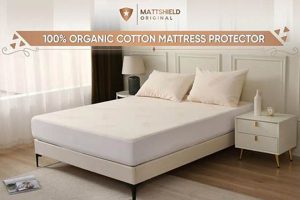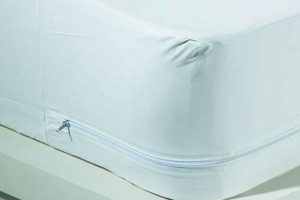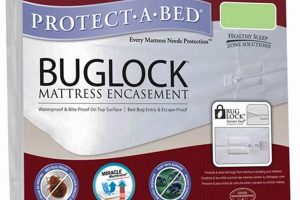The question of whether safeguarding bedding with a specialized covering is essential often arises. This consideration involves evaluating the potential advantages and disadvantages of utilizing such a protective measure for sleep surfaces. For example, individuals purchasing a new, high-end bed may contemplate whether a barrier is needed to maintain its condition and warranty.
Employing a bedding shield offers multiple advantages. It provides a defense against spills, stains, and allergens, potentially extending the lifespan of the underlying mattress. Historically, these coverings were simple, utilitarian items. However, modern iterations offer enhanced features such as waterproofing, breathability, and allergen resistance, contributing significantly to hygiene and comfort.
The ensuing discussion will delve into the practical considerations, financial implications, and health benefits associated with using a bedding protector. This will include an examination of different types of protectors, their materials, and their suitability for various needs and circumstances.
Guidance on Bedding Protection
The subsequent guidance addresses key considerations when evaluating the need for mattress protection, aiming to inform decision-making based on practical benefits and requirements.
Tip 1: Evaluate Warranty Conditions: Prior to foregoing a protective covering, meticulously review the mattress warranty. Many warranties are voided by stains or liquid damage, making a protector a cost-effective safeguard.
Tip 2: Consider Allergen Sensitivity: Individuals with allergies or asthma may benefit significantly from the barrier a protector provides against dust mites and other allergens that accumulate in mattresses.
Tip 3: Assess Lifestyle Factors: Homes with children, pets, or frequent spills necessitate a higher level of protection. Waterproof or water-resistant options are particularly advisable in these situations.
Tip 4: Factor in Mattress Investment: The cost of the mattress should influence the decision. Protecting a high-end mattress is a prudent investment compared to replacing it prematurely.
Tip 5: Explore Material Options: Different materials offer varying levels of protection and comfort. Research options such as cotton, polyester, and specialized waterproof membranes to determine the best fit.
Tip 6: Maintain Proper Hygiene: Regular cleaning of the protector itself is crucial. Follow the manufacturer’s instructions to ensure its continued effectiveness and longevity.
Tip 7: Recognize Limitations: While a protector offers significant defense, it is not impervious. Promptly address spills and stains, even with a protector in place.
In summary, integrating protective measures for bedding presents a proactive approach to preserving the mattress’s integrity, enhancing hygiene, and potentially extending its usability. Assessing the specific needs and conditions is paramount.
The concluding section will synthesize the preceding information, offering a final perspective on the overall value and relevance of bedding protection.
1. Protection
The primary function inherently associated with the need for a mattress protector is its capacity to shield the mattress from various forms of damage and degradation. This protective function serves as a fundamental justification for its employment. Liquid spills, bodily fluids, dust, and physical abrasions pose continuous threats to the integrity and lifespan of a mattress. A protector acts as a physical barrier, mitigating these risks and preserving the mattress’s condition. For example, accidental beverage spills, common in households, can lead to staining, odor development, and even mold growth within the mattress core. A protector, particularly a waterproof variety, effectively contains such spills, preventing penetration and subsequent damage.
Furthermore, the protective quality of a mattress protector extends beyond immediate incident mitigation. It guards against the gradual accumulation of dust mites, skin cells, and other allergens that can compromise hygiene and potentially exacerbate respiratory ailments. This aspect of protection is especially significant for individuals with allergies or asthma. In practice, consistent use of a protector can significantly reduce the need for frequent and costly professional mattress cleaning. For instance, healthcare facilities frequently implement mattress protection protocols to maintain sanitary conditions and minimize the spread of pathogens, demonstrating the practical significance of protective barriers in high-stakes environments.
In conclusion, the degree to which a mattress requires protection is directly proportional to the perceived necessity of a mattress protector. The multifaceted protective benefits, ranging from spill containment to allergen control, underscore the inherent value of a barrier. Though challenges such as cost and potential comfort alterations exist, the long-term preservation of mattress integrity and hygiene often outweigh these concerns, solidifying the connection between the need for protection and the perceived necessity of a dedicated mattress protector.
2. Hygiene
Maintaining cleanliness in bedding contributes significantly to overall health and well-being, creating a clear connection between the question of mattress protection and the importance of hygiene. A mattress, by its nature, accumulates bodily fluids, shed skin cells, and dust mites over time, establishing an environment conducive to bacterial and fungal growth. These factors collectively diminish hygienic conditions, potentially leading to allergic reactions, skin irritations, and respiratory issues. Therefore, preserving a sanitary sleep surface is a fundamental consideration.
Mattress protectors create a barrier against these contaminants, preventing them from penetrating the mattress fibers. This protective layer simplifies routine cleaning and maintenance, allowing for easy removal and washing of the protector. In contrast, cleaning a stained or contaminated mattress is often difficult, requiring specialized cleaning solutions or professional services. For instance, hospitals routinely use mattress protectors to prevent the spread of infection between patients. Similarly, hotels rely on these safeguards to provide a clean and hygienic sleeping environment for their guests. These real-world applications underscore the practical significance of mattress protection in maintaining proper hygiene standards.
Consequently, prioritizing hygiene plays a crucial role in determining whether a mattress protector is necessary. The ability to easily maintain a clean and sanitary sleeping surface outweighs the nominal cost and potential inconvenience of using a protector. While diligent cleaning practices can mitigate some risks, a protector provides an additional layer of defense against contaminants, ultimately promoting a healthier and more hygienic sleep environment. Its regular use directly supports the broader goal of maximizing health and well-being by addressing a key factor in creating a clean sleep surface.
3. Warranty
The correlation between a mattress warranty and the question of protective measures is significant. Many mattress manufacturers stipulate conditions that, if unmet, void the warranty. A common condition involves damage resulting from stains or liquid exposure. Since a mattress protector serves as a barrier against such incidents, its absence can directly impact warranty validity. Thus, evaluating warranty terms becomes a crucial step in determining whether a mattress protector is required to maintain coverage.
For example, a warranty might specify that any visible stain renders the warranty null and void. In such cases, even a minor spill, if not adequately contained, could negate the warranty’s protective provisions. This risk carries considerable financial implications, particularly when considering the cost of replacing a high-quality mattress. The practical application of this understanding involves thoroughly reviewing the warranty document upon purchase, identifying clauses related to stains and liquid damage, and recognizing the mattress protector as a means of preemptively satisfying those requirements. Failure to do so can lead to unforeseen expenses and the loss of the warranty’s intended benefits.
In conclusion, understanding the relationship between warranty terms and protective measures is paramount. The potential for voiding a warranty due to preventable damage makes the utilization of a mattress protector a prudent choice for many consumers. While challenges exist, such as the initial cost of the protector, the long-term financial security and peace of mind derived from upholding the warranty typically outweigh these considerations, solidifying the connection between the need to maintain warranty coverage and the perceived requirement of a mattress protector.
4. Allergies
The prevalence of allergic sensitivities significantly influences the perceived necessity of a mattress protector. The sleeping environment can harbor numerous allergens, impacting the health and comfort of susceptible individuals. A focused examination of specific facets illuminates this relationship.
- Dust Mite Mitigation
Dust mites thrive in mattresses, feeding on shed skin cells. Their waste products are potent allergens, triggering respiratory and dermatological reactions. A mattress protector acts as a barrier, preventing dust mites from colonizing the mattress core. The encasement reduces exposure and minimizes allergic responses. For instance, individuals with diagnosed dust mite allergies often experience reduced symptoms when using a protector compared to sleeping on an unprotected mattress.
- Allergen Barrier Function
Mattresses accumulate various allergens beyond dust mites, including pet dander, mold spores, and pollen. These allergens can penetrate the mattress fibers, creating a reservoir of irritants. A protector, particularly one designed with a tightly woven fabric, impedes the passage of these allergens, maintaining a cleaner sleep surface. Consider individuals with seasonal allergies who find relief by reducing allergen exposure in the bedroom, partly achieved through mattress protection.
- Simplified Cleaning and Maintenance
Regular washing of bedding, including mattress protectors, removes accumulated allergens. Cleaning an entire mattress to eliminate allergens is significantly more challenging. A protector simplifies maintenance by acting as a removable and washable barrier. For example, weekly washing of a protector can significantly reduce allergen levels compared to attempting to clean a mattress directly.
- Health Impact on Sensitive Individuals
The accumulation of allergens in a mattress can exacerbate pre-existing respiratory conditions, such as asthma, and trigger allergic rhinitis. Children and the elderly are particularly vulnerable. A mattress protector mitigates allergen exposure, potentially improving sleep quality and overall respiratory health. Healthcare providers frequently recommend mattress protectors to patients with known allergies or respiratory sensitivities.
These facets collectively illustrate the significant role mattress protectors play in managing allergen exposure within the sleeping environment. While not a panacea, they provide a proactive approach to minimizing allergic triggers, improving sleep hygiene and overall health for sensitive individuals. Thus, the presence of allergies, or even a predisposition to them, elevates the perceived and actual necessity of a mattress protector.
5. Investment
The financial expenditure represented by a mattress constitutes a significant investment for most individuals and households. This investment necessitates consideration of strategies to preserve the value and longevity of the purchased item. A primary method for achieving this preservation involves utilizing a mattress protector. The protector functions as a safeguard against various forms of damage that can depreciate the mattress’s condition and, consequently, its value. This cause-and-effect relationship highlights the protector’s role in protecting the initial investment.
The importance of the investment component is underscored by the potential costs associated with mattress replacement. Premature degradation due to spills, stains, or infestations necessitates either costly professional cleaning or complete replacement. The cost of a quality protector is typically a fraction of the expense incurred by either of these alternatives. For instance, individuals who purchase high-end mattresses with advanced comfort technologies stand to lose a substantial amount if the mattress is damaged beyond repair. The protector functions as a form of insurance, mitigating the risk of such loss. Furthermore, many mattress warranties are contingent upon maintaining the mattress in pristine condition, making a protector essential for preserving warranty coverage and protecting the initial financial outlay.
In conclusion, a rational assessment of the financial commitment associated with mattress ownership necessitates consideration of a mattress protector. While the protector represents an additional upfront expense, it functions as a prudent investment in long-term value preservation. By mitigating risks of damage and preserving warranty coverage, the protector safeguards the initial financial outlay, ultimately aligning with sound financial planning principles. The benefits are weighed by the costs, emphasizing a balance of investment in extending mattress lifespan.
6. Longevity
The lifespan of a mattress, its longevity, is intrinsically linked to the use of a mattress protector. A mattress, without protective measures, is directly exposed to factors that accelerate its degradation. Spills, body fluids, dust, and the accumulation of allergens collectively contribute to the breakdown of materials and the reduction of overall lifespan. A protector acts as a preventative barrier, mitigating these destructive influences, and thereby extending the useful life of the mattress. The absence of such a safeguard increases the likelihood of premature replacement, incurring additional expenses and environmental impact.
Consider, for example, the hospitality industry. Hotels, facing constant occupancy and diverse user habits, rely heavily on mattress protectors. These protectors are not merely about hygiene; they are strategic investments in extending the lifespan of their mattress inventory. By preventing stains and damage, protectors minimize the need for frequent mattress replacements, significantly reducing operational costs over time. Similarly, in residential settings, the consistent use of a protector can postpone the need for mattress replacement by several years, effectively lowering the long-term cost of sleep furnishings. The practical significance of this understanding lies in recognizing the mattress protector as a preventative measure, rather than simply an optional accessory.
In conclusion, the relationship between mattress longevity and the deployment of protective measures is unequivocally causal. While factors such as mattress quality and usage patterns also influence lifespan, the presence of a protector provides a tangible extension of the mattress’s useful life. The value proposition of a protector is further reinforced by reduced replacement costs and the minimization of environmental waste. The challenge lies in overcoming the perception of the protector as an unnecessary expense and recognizing it as a prudent investment in the long-term health and value of the mattress.
Frequently Asked Questions Regarding Mattress Protectors
The following addresses common inquiries related to mattress protectors, providing factual and objective answers.
Question 1: Is a mattress protector necessary for all types of mattresses?
While the benefits extend to all mattress types, the necessity is contingent upon individual circumstances. High-end mattresses and those with specific care requirements benefit most significantly. Budget-friendly mattresses also gain extended lifespans through protection.
Question 2: How frequently should a mattress protector be washed?
Mattress protectors require washing every one to two months under typical conditions. More frequent washing is advised in cases of spills, heavy perspiration, or allergen sensitivities. Adherence to manufacturer instructions is crucial.
Question 3: Does a mattress protector alter the comfort level of a mattress?
Certain mattress protectors, particularly those made from thicker or less breathable materials, may slightly alter the comfort level. Selecting a protector designed for breathability and minimal interference can mitigate this concern.
Question 4: Are all mattress protectors waterproof?
Not all mattress protectors provide waterproofing. The level of protection varies based on the materials used. Consumers requiring waterproofing should specifically seek out protectors labeled as such.
Question 5: Can a mattress protector prevent bed bug infestations?
While a mattress protector can provide a degree of protection against bed bugs, it is not a guaranteed preventative measure. Encasement-style protectors offer greater defense by completely sealing the mattress.
Question 6: Do mattress protectors void the mattress warranty if used?
Using a mattress protector does not inherently void the warranty. In fact, many warranties stipulate that failing to use a protector can invalidate the coverage in case of stains or liquid damage.
In summation, mattress protectors present a valuable tool for safeguarding mattresses, promoting hygiene, and potentially extending lifespan. Individual requirements and mattress characteristics should guide the decision-making process.
The subsequent section will provide a concluding summary, consolidating insights gleaned from the preceding discussion.
Conclusion
The foregoing analysis confirms that the decision regarding is a mattress protector necessary is multifaceted, contingent upon a synthesis of financial, hygienic, and protective considerations. While not universally mandated, the advantages afforded by a mattress protector including enhanced hygiene, extended mattress lifespan, warranty preservation, and allergen mitigation establish a compelling case for its implementation in many scenarios. The long-term benefits frequently outweigh the initial expenditure, particularly when considering the substantial investment a mattress represents.
Ultimately, the selection of whether or not to employ bedding protection should be grounded in a thorough evaluation of individual requirements, lifestyle factors, and financial constraints. Ignoring the potential benefits, however, introduces significant risks to mattress integrity and overall sleep health. Therefore, a proactive and informed approach is advised to ensure optimal protection and longevity of this essential furnishing.





![Shop Best Tencel Mattress Protector [Eco-Friendly] Organic & Natural Mattress Buyer’s Guide: Non-Toxic Sleep Solutions Shop Best Tencel Mattress Protector [Eco-Friendly] | Organic & Natural Mattress Buyer’s Guide: Non-Toxic Sleep Solutions](https://mattressworldpa.com/wp-content/uploads/2025/07/th-2502-300x200.jpg)

